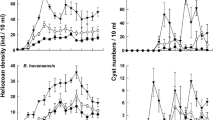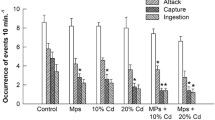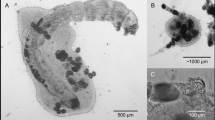Abstract
Population growth rates of the predatory rotifer Asplanchna brightwelli were determined at 25 °C using a large (Brachionus calyciflorus) and a small (Anuraeopsis fissa) rotifer prey species in three concentrations (0.5, 0.1 and 2.0 μg dry weight ml-1) and in five combinations. The prey ingestion time by the predator was also measured. For B. calyciflorus the ingestion time (22.97–8.95 s) was more than six times that of A. fissa (3.68 ± 0.93). Regardless of prey type, the population growth of Asplanchna increased with increasing food density. There was a direct correlation between densities of amictic and mictic fernales. The maximum rate of population growth (1.01 ± 0.10 d-1) was higher at high density of A. fissa prey than that at the same density of B. calyciflorus. Progressive increase of A. fissa density in the offered food combination resulted in a corresponding increase of the predator's number. Gut content analysis of A. brightwelli revealed that the number of prey ingested increased with increasing prey densities.
Similar content being viewed by others
References
Anon, 1985. Methods for measuring the acute toxicity of effluents to freshwater and marine organisms. US Environmental Protection Agency, EPA/600/485/013.
Arndt, H., 1993. Rotifers as predators on components of the microbial web (bacteria, heterotrophic flagellates, ciliates): A review. Hydrobiologia 255/256: 231–246.
Bottrell, H. H., A. Duncan, Z. M. Gliwicz, E. Grygierek, A. Herzig, A. Hillbricht-Ilkowska, H. Kurasawa, P. Larsson & T. Weglenska, 1976. A review of some problems in zooplankton production studies. Norw. J. Zool. 24: 419–456.
Commins, M. L. & G. W. Salt, 1988. Some patterns of predation and prey selection by the rotifer Asplanchna girodi in replicated outdoor tanks. Verh. int. Ver. Limnol. 23: 2028–2032.
Conde-Porcuna, J. M. & S. S. S. Sarma, 1995. Prey selection by Asplanchna girodi (Rotifera): the importance of prey defence mechanisms. Freshwat. Biol. 33: 101–108.
Conde-Porcuna, J. M., R. MoralesBaquero & L. CruzPizarro, 1993. Dinamica poblacional y habitos alimenticios en dos especies congenericas (Asplanchna girodi y Asplanchna priodonta). In CruzPizarro, L. (ed.), Actas VI Congreso Espanol de Limnologia. Granada: 221–227.
Dumont, H. J., 1977. Biotic factors in the population dynamics of rotifers. Arch. Hydrobiol. Beih. 8: 98–122.
Dumont, H. J. & S. S. S. Sarma, 1995. Demography and population growth of Asplanchna girodi (Rotifera) as a function of prey (Anuraeopsis fissa). Hydrobiologia 306: 97–107.
Dumont, H. J., I. Van de Velde & S. Dumont, 1975. The dry weight estimate of biomass in a selection of cladocera, copepoda and rotifera from the plankton, periphyton and benthos of continental waters. Oecologia 19: 75–97.
Dumont, H. J., S. S. S. Sarma & A. J. Ali, 1994. Laboratory studies on the population dynamics of Anuraeopsis fissa (Gosse) (Rotifera) in relation to food density. Freshwat. Biol. 3: 39–46.
Garreau, F., C. Rougier & R. Pourriot, 1988. Resource exploitation by the planktonic predator Asplanchna girodi De Guerne 1888 (Rotifera) in a sand-pit lake. Arch. Hydrobiol. 112: 91–106.
Gaudy, R., G. Verriopoulos & G. Cervetto, 1995. Space and time distribution of zooplankton in a Mediterranean lagoon (Etang de Berre). Hydrobiologia 301: 219–236.
Gilbert, J. J., 1967. Asplanchna and posterolateral spine production in Brachionus calyciflorus. Arch. Hydrobiol. 64: 1–62.
Gilbert, J. J., 1980a. Observations on the susceptibility of some protists and rotifers to predation by Asplanchna girodi. Hydrobiologia 73: 87–91.
Gilbert, J. J., 1980b. Feeding in the rotifer Asplanchna: behaviour, cannibalism, selectivity, prey defenses, and impact on rotifer communities. In Kerfoot, W. C. (ed.), Evolution and Ecology of Zooplankton Communities. University Press of England, Hanover: 158–172.
Green, J. & O. B. Lan, 1974. Asplanchna and the spines of Brachionus calyciflorus in two Javanese sewage ponds. Freshwat.Biol. 4: 223–226.
Guiset, A., 1977. Stomach contents in Asplanchna and Ploesoma. Arch. Hydrobiol Beih. 8: 126–129.
Halbach, U., 1969. Das Zusammenwirken von Konkurrenz and Raube-Beute-Beziehungenbei Radertieren. Zool. Anz. Suppl. 3: 72–79.
Iyer, N., 1989. Biology of the predatory rotifer Asplanchna: a review and some field and laboratory studies. M. Phil. thesis, University of Delhi, India, 99 pp.
Iyer, N. & T. R. Rao, 1996. Responses of the predatory rotifer Asplanchna intermedia to prey species differing in vulnerability: laboratory and field studies. Freshwat. Biol. 6: 521–533.
Kerfoot, W. C., W. R. DeMott & C. Levitan,1985. Non-Linearities in competitive interactions: component variables or system response? Ecology 66: 959–965.
King, C. E. & T. W. Snell, 1980. Density dependent sexual reproduction in natural populations of the rotifer Asplanchna girodi. Hydrobiologia 73: 149–152.
Miracle, M. R. & M. Serra, 1989. Salinity and temperature influence in rotifer life history characteristics. Hydrobiologia 186/187: 81–102.
Mitchell, S. F., F. R. Trainor, P. H. Rich & C. E. Goulden, 1992. Growth of Daphnia magna in relatlon to the nutritional state of its food species, Chlamydomonas reinhardtii. J. Plankton Res. 14: 379–391.
Pourriot, R., 1974. Predator-prey relationships in rotifers: effect of the predator (Asplanchna brightwelli) on the morphology of the prey (Brachionus bidentata). Ann. Hydrobiol. 5: 43–55.
Pourriot, R., 1977. Food and feeding habits of the Rotifera. Arch. Hydrobiol. Beih. 8: 243–260.
Rothhaupt, K. O., 1990. Population growth rates of two closely related rotifer species: Effects of food quantity, particle size and nutritional quality. Freshwat. Biol. 23: 561–570.
Ruttner-Kolisko, A., 1977. Suggestions for biomass calculation of plankton rotifers. Arch. Hydrobiol. Beih. 8: 71–76.
Salt, G. W., 1977. An analysis of the diets of five sympatric species of Asplanchna. Arch. Hydrobiol. Beih. 8: 123–125.
Salt, G. W., 1989. Comparisons of the diets and reproductive performances of two sympatric rotifers, Asplanchna girodi and Asplanchna priodonta. Freshwat. Biol. 22: 417–430.
Sarma, S. S. S., 1993. Feeding responses of Asplanchna brightwelli (rotifera): laboratory and field studies. Hydrobiologia 255/256: 275–282.
Smith, V. H., 1991. Competition between consumers. Limnol. Oceanogr. 36: 820–823.
Stemberger, R. S. & J. J. Gilbert, 1984. Body size, ration level and population growth in Asplanchna. Oecologia 64: 355–359.
Stemberger, R. S. & J. J. Gilbert, 1987. Defenses of planktonic rotifers against predators. In Kerfoot, W. & A. Sih (eds), Predation: Direct and Indirect Impacts on Aquatic Communities. University Press of New England, Hanover, NH: 227–239.
Vanni, M. J. & W. Lampert, 1992. Food quality effects on life history traits and fitness in the generalist herbivore Daphnia. Oecologia 92: 48–57.
Williamson, C. E., 1983. Invertebrate predation of planktonic rotifers. Hydrobiologia 104: 385–396.
Williamson, C. E. & J. J. Gilbert, 1980. Variation among zooplankton predators. The potential of Asplanchna, Mesocyclops and Cyclops to attack, capture and eat various rotifer prey. In Kerfoot, W. C. (ed.), Evolution and ecology of zooplankton communities. University Press of New England, Hanover: 509–517.
Author information
Authors and Affiliations
Rights and permissions
About this article
Cite this article
Sarma, S.S.S., Nandini, S. & Dumont, H.J. Feeding preference and population growth of Asplanchna brightwelli (Rotifera) offered two non-evasive prey rotifers. Hydrobiologia 361, 77–88 (1997). https://doi.org/10.1023/A:1003189312452
Issue Date:
DOI: https://doi.org/10.1023/A:1003189312452




